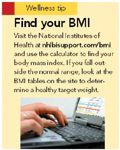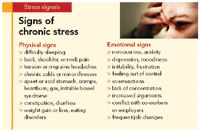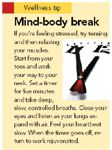Get out of your unhealthy rut
Don't wait until you collapse on the floor of your clinic to make much-needed changes to your lifestyle. Personal wellness is crucial to fulfilling, successful practice ... and it could save your life.
THE CRISIS THAT PUSHED ME OVER the edge came in two stages. The first was a photograph taken by a buddy of mine at the beach when he and his family came to North Carolina to visit. The snapshot showed a portly man with love handles, a pale belly, and a flabby chest. It also showed dark circles under the eyes, sallow skin, and a hollow smile. It must have been that harsh outdoor light. I was just under 5-foot-8 and weighed a reasonable 168 pounds. Sure, I was working a lot and had put on a few pounds, but everyone did in their 30s. Still, that picture bothered me.

Dr. Ernest E. Ward Jr., DVM
The second stage occurred a month later at a veterinary conference where I was speaking. Free blood screenings were being offered and I thought, why not? Two weeks later I received my results: high cholesterol.
How could this be? I was young; I was a vegetarian; I rarely drank and never smoked; I wasn't obese. The culprit turned out to be genetics combined with a less-than-ideal lifestyle. I remembered that awful beach picture as I stared at the lab results in my hand. It was time to change, or I'd soon be lying in intensive care like my father was a decade earlier.

Get out of that rut
Like many veterinarians, I had withdrawn into a comfort zone. Not that my zone was all that comfortable; it was chaotic and messy and stressful—but it was familiar. I didn't think I could do much to change it. I was a veterinarian, after all.

Find your BMI
The fact is that anyone can improve their health and well-being and regain control of life. When you're performing at a subpar level physically or emotionally, you aren't the best doctor you can be. You aren't as productive or efficient, you don't lead your team as effectively, and you don't appear as compassionate or competent to your clients. In short, you're not providing the highest standard of veterinary care.
A recent issue of the International Journal of Aging and Human Development defines a "rut" as "an overadaptation to our own routines and expectations, producing 'hyperhabituation,' mental stagnation, and neophobic response orientations." In other words, we stop pushing ourselves, we become complacent, and we become fearful of anything new. Ruts develop gradually, and most of us don't realize we're stuck until we're forced to acknowledge it. Usually by a catastrophe.

Schedule ahead
Don't wait for the heart attack
I've heard too many heartbreaking stories about veterinarians who collapsed in their clinics from heart attacks, strokes, and worse because they ignored their own health. Don't wait for a heart attack to become concerned about your health. Don't take preventive measures after you've been diagnosed with cancer. Don't treat hypertension after you've developed it. Challenge yourself and get started today.

How many calories?
As I reflected on my own health that day more than eight years ago, I realized that I owed it to everyone around me to maintain optimal health. My future children needed me to be energetic and to teach them to be physically active. My wife needed me to be the best partner she could dream of and not leave her an early widow or caretaker of a type 2 diabetic. My staff, clients, and patients needed me to be physically strong and mentally stable so I could provide leadership and offer the highest standards of medical care.

Healthy weight ranges
And I owed it to myself to push myself to new limits and redefine middle age. I had been given this wonderful mind and a capable body—how thoughtless to waste them in a gradual decline. I vowed that day to stop letting my day-to-day life determine my direction and to reclaim control of my mind, body, and spirit. I got out of the rut, but it wasn't easy and didn't happen overnight.
Establish your baseline
If you realize you're in your own rut as you read this, you're not alone. According to the Centers for Disease Control, approximately two-thirds of adult Americans are overweight, and a staggering 30 percent are obese. More than 9 million of us are at least 100 pounds overweight. The CDC also reports that less than half of us get the minimum recommended exercise: 30 minutes of aerobic activity at least five days a week. The National Institute for Occupational Safety and Health reports that up to 40 percent of all workers report feeling "stressed out," "burned out," or "extremely stressed" by their work on a regular basis. And workplace stress costs the nation more than $300 billion each year in healthcare costs and missed work, according to the American Institute for Stress in New York.

Count your steps
The great news is that you can control your weight and stress level. You can't magically erase problems from your life, but you can change how you eat and exercise and how you respond to stress. The even better news is that by making positive changes, you'll decrease your risk of heart disease, high blood pressure, type 2 diabetes, and many forms of cancer. Plus you'll boost your immune system, enjoy increased energy, and have an optimistic outlook on life. In fact, most studies show you'll live a longer and more enjoyable life. Isn't that worth a little effort?

Waist management
The first step to reclaiming your wellness is to measure where you are today. Weigh yourself and measure your height. Once you have these two values, you can calculate your body mass index (BMI). A normal BMI for adults is between 18.5 and 24.9, according to the CDC, but most fitness experts agree that an ideal BMI is 20 to 22. Once you see where you are on the BMI scale (see "Find your BMI"), you can aim for a healthy weight. If you need to lose weight, aim to do so gradually at a general rate of one-half to two pounds per week. The best way to lose weight is to eat less and exercise. And you thought this was going to be complicated!
Doctor, see thy doctor
As veterinarians we tell our clients to have their pet examined by a doctor once or twice every year. Before you dispense that advice again, ask yourself, "Do I take my own medicine?" If not, make an appointment today for a physical examination, and continue to have one at least once a year. Remember that you'll probably need to initiate a discussion about weight reduction and life extension. Most doctors are accustomed to treating infections and other immediate concerns and rarely talk about maintaining health, much less preventing future maladies.
Make sure you're healthy enough to begin an exercise program and ask your doctor for recommendations for a personal trainer or gym. Get a complete blood and urine profile (sound familiar?) and any other age-appropriate tests. I suggest that you also request C-reactive protein, homocysteine, and apolipoprotein A testing along with a fractionated cholesterol panel annually.

Signs of chronic stress
Eat less
I became a certified personal trainer in 2005 because I wanted to learn more about fitness and help others achieve wellness goals. More important, I was increasingly alarmed by the number of overweight patients and clients I was seeing. I wanted my clients to understand that their pets' weight-related problems could plague them too if they didn't control their weight and lifestyle. Improving my own physical well-being had rescued me from burnout and retrieved me from the edge of depression and breakdown. I was happier and more energetic, and I wanted everyone to enjoy those same feelings.

Mind-body break
So in that spirit, I want to help my busy colleagues make the changes that helped me. If you need to shed pounds, here are a few simple tips:
- Don't drink your calories. A 20-ounce Coke has 250 calories. That's 10 percent of the daily caloric requirements for a man and 12.5 percent for a woman! Drink less coffee and soda and drink more water. You'll feel fuller and avoid empty calories that alter your glycemic index. Aim for eight 8-ounce glasses a day. Your skin and your waistline will thank you.
- Eat breakfast every day. This is the time to eat carbohydrates you'll need for energy. Avoid high-sugar foods (including doughnuts!) and concentrate on whole grains and fruits. Try a fruit smoothie with vegetables thrown in. My favorite trick is to add spinach to a strawberry-blueberry-banana smoothie.
- Eat a healthy snack at 10 a.m. and 4 p.m. Nuts, whole grains, and fruit are great low-calorie energy boosters that will help keep candy bars and chips away from your belly and thighs.
- Forget fad diets and focus on lifestyle. Diets are trendy—there's the day-of-the-week diet, eye-color diet, favorite-color diet—while wellness is a lifestyle. Take stock of what you like, accent the healthy choices, and eliminate or reduce not-so-healthy items. Increase your servings of vegetables and fruits—five is fine, but nine is divine. For maximum health benefit, choose the most colorful fruits and vegetables.
- Fill your plate two-thirds full of vegetables and fruits. Limit breads and meats to one-third of your total intake.
- Count calories. Don't obsess, but keep a general idea of how many calories you're taking in at each snack or meal. Knowing that you're about to eat 400 calories of chips may encourage you to substitute an apple!
Get moving
By now, word is out that moderate-intensity physical activity can reduce the risk of many diseases, especially type 2 diabetes, heart disease, and hypertension. The CDC recommends that everyone engage in at least 30 minutes of moderate-intensity activity five days a week, preferably daily. Moderate-intensity activities are those that cause you to burn 100 to 200 kilocalories in a thirty-minute period. Activities such as walking at a brisk pace, slow cycling, yoga, doubles tennis, and light strength training are excellent examples. Sorry, but golf counts only if you carry your clubs. If walking the dog is your preferred exercise, make sure that the walk is uninterrupted and that you both limit breaks. Stay focused on maintaining a constant pace—walk now, talk with neighbors later.
If you want more of a challenge, the CDC recommends engaging in vigorous physical activity three or more days per week for 20 or more minutes. Jogging, running, cycling faster than 10 mph, aerobics, singles tennis, and most competitive sports are typical vigorous-intensity activities.
Set fitness goals and share them with family and co-workers. My best advice is to post them so others can see them and offer support. If you set goals in private, you're more likely to shift or abandon them when things get challenging. If you want to lose 10 pounds and complete a 5K run in four months, chart out a plan that starts with losing two pounds in the next three weeks and jogging a mile within four weeks. Think in 10 percent terms: lose 10 percent of your weight goal in one to two weeks and increase your walking or jogging mileage by 10 percent each week. Start small but end with a big goal. Once you've achieved your initial goal, continue challenging yourself! Fitness and health is a journey, not a destination.
Recognize the signs of stress
In the United States, the combined costs of stress-related disorders to the work industry from absenteeism, insurance and health costs, and diminished productivity are thought to run about $85 billion, according to government estimates. The cost of stress-related coronary heart disease alone is thought to be in excess of $35 billion.
In addition, mind and body influence each other strongly. To put it another way, new research suggests that depression can cause heart disease and heart disease can cause depression. Our emotional state largely determines our physical well-being. Some researchers have suggested that stress contributes to as much as 90 percent of all illnesses.
We work in a volatile, spontaneous, and unpredictable profession. In fact, it was these attributes that attracted many of us to the practice of veterinary medicine. Unfortunately, these conditions can lead to self-destruction, illness, and unhappiness. In worst-case scenarios, depression and burnout can result in career casualty.
Because chronic stress can wreak havoc on the mind and body, it is important to seek to reduce stress as much as possible. One of the most important steps is to learn to recognize the signs of chronic stress. See "Signs of Chronic Stress," above, to learn what to look for and to see if you're suffering any of these effects.
If you recognize any of the warning signs, don't worry. Instead celebrate that you've taken one of the most important steps in improving your life. Now it's time to do something about that dangerous stress.
Manage stress
Since stress is an inevitable part of life, it's important to learn to cope with it effectively. First, identify what parts of your life create the most stress. If it's working late or running behind schedule, take steps to control both. You can control your appointment schedule. You can control the majority of the things you might think are uncontrollable. This is where time management and delegation skills become crucial—don't believe the voice in your head that says you're the only one who can handle a situation.
It's also important to leave work on time. Of all the stressors in the veterinary workplace, staying late is the biggest and most damaging. If you can't recall what you had for dinner the past two nights, you're probably stressed out and working too late! Once you identify the stressful parts of your life, improve or avoid them.
Next, begin a regular exercise program. Nothing busts stress like a good sweat! Eating a healthy, well-balanced diet low in refined sugars will also help reduce your stress redline. Laugh at the chaos; find humor in the absurd and stressful. A smile goes a long way toward loosening the shackles of stress.
Looking for a new approach? Consider taking up yoga. For thousands of years one of the largest cultures on our planet has used this simple and highly effective technique to improve mental and physical health. If you don't have access to yoga classes, buy a DVD and learn at home. The increased flexibility and relaxation that yoga provides will boost your immune system, improve cardiac function, and strengthen bones and muscles. And yoga isn't just for women. I know Ironman triathletes and football players who incorporate yoga into their rigorous training schedules.
It's in you
How many times have you seen someone look at a 5-year-old and remark, "I wish I had that energy." Each of us does have that energy; it's just that we've forgotten where it is. It lies within us, eager to be awakened through the power of wellness. Tap into it and powerful things will happen in your life.
Dr. Ernest E. Ward Jr., a Veterinary Economics Editorial Advisory Board member, owns Seaside Animal Clinic in Calabash, N.C. Send questions or comments to ve@advanstar.com